Mini review Article / Open Access
DOI:10.31488/bjg.1000123
Effect of Continuous Intake of Onion Outer Skin Powder on Human Microbiota: A Preliminary Intervention Study and In Vitro Fecal Culture Study
Koji Nomoto*, Genki Yamaguchi, Erika Suzuki, Daiki Kobayashi
1. Department of Molecular Microbiology, Tokyo University of Agriculture, Japan
* Corresponding author: Koji Nomoto, Department of Molecular Microbiology, Tokyo University of Agriculture, 1-1-1 Sakuragaoka, Setagaya, Tokyo 156-8502, Tel: +81-3-5477-3174
Abstract
The primary objective of this preliminary intervention study was to clarify the effect of continuous intake of onion outer skin powder granules (onion peel powder made into granules with edible excipients) on human intestinal microflora by molecular microbiological methods. Furthermore, the second objective was to isolate bacterial strains that show characteristic growth by successive cultivation in human fecal medium supplemented with onion peel powder, and to obtain basic data such as their role in quercetin metabolism. Although statistically significant results could not be expected due to the small number of subjects, the results suggest that the intake of onion skin granules tends to improve physical condition and stabilize the frequency of defecation. In addition, no problematic side effects such as abdominal symptoms were observed, suggesting the safety of this product. Periodical quantitative PCR analysis for four most predominant anaerobic bacteria groups in the intestine showed that the number of bacteria in each group tended to decrease during the first week of intake, but rebounded during the second week of intake and after intake, and was similar to or higher than the level before intake. Organic acid concentration in the subjects’ fresh feces suggested that continuous intake of onion skin grains may cause significant changes in the intestinal environment within a relatively short period of time after the start of intake. In vitro anaerobic culture of the fresh feces with existence of the onion outer skin powder showed significant production of SCFAs and degradation of quercetin, in which characteristic metabolic patterns were observed according to the subject's feces, and only certain bacterial isolates were found to break down quercetin when incubated with existence of onion skin powder in vitro. Further studies are needed to clarify that what kind of the indigenous microorganisms are responsible for the metabolism of the potential bioactive onion outer skin powder in the gut.
Introduction
Onions are considered to be one of the oldest cultivated plants in existence, and have been cultivated as a vegetable since around 1885 in Japan. Now, onions have become a common ingredient in the Japanese diet. Usually, the outer skin of onions is not used for food and is discarded. In Hyogo Prefecture, a major producer of onions in Japan, attempts to reuse onion peels, which are industrial wastes, and co-investigators have successfully powdered onion peels and made them available for human consumption. Onion outer skin powder contains dozens of times more quercetin than the edible part, and the ratio of quercetin to aglycone is higher than in the edible part. Quercetin is a plant flavonoid that has been reported to exert a variety of physiological effects, including antioxidant, anti-inflammatory, anti-atherosclerotic, cardiovascular disease prevention, anti-tumor and antihypertensive effects [1-5]. Quercetin is also known to improve intestinal flora abnormalities related to obesity [6]. In addition, various metabolites produced by the metabolism of quercetin by a limited variety of anaerobic bacteria in the gut have also been reported to have positive health effects [7].
On the other hand, onion outer skin powder contains dietary fiber at a rate of over 70%. "Microbiota Accessible Carbohydrates (MACs) " (carbohydrates available to the intestinal flora) is a concept that from the perspective of the metabolism of indigestible carbohydrates by gut microbes, actively consuming dietary fiber to facilitate this is beneficial to health [8]. Normally, the effective energy of indigestible dietary fiber is much lower than that of normal easily digestible carbohydrates, but when it reaches the large intestine without being broken down in the small intestine, it is broken down by anaerobic commensal bacteria in the large intestine to produce organic acids such as acetic, butyric, and propionic acids. These organic acids are thought to be important in maintaining intestinal flora homeostasis in the lower gastrointestinal tract. For example, acetic acid performs important functions in the weakly acidic environment of the colon, such as suppressing the abnormal growth of opportunistic bacteria (facultative anaerobes such as coliforms and staphylococci and toxin-producing opportunistic pathogens such as Clostridium perfringens) and maintaining the integrity of the intestinal epithelial barrier. Host receptors that specifically recognize organic acids have also been reported and have been found to convey obesity-controlling stimuli such as suppressing appetite and stimulating the sympathetic nervous system to promote energy expenditure [9].
Few studies have been conducted on the efficacy of onion outer skin powder, which is considered to have high potential health benefits, in humans. Therefore, the primary purpose of this preliminary open study was to clarify the effect of continuous intake of onion outer skin powder supplements on human intestinal microbiota by molecular microbiological methods. Furthermore, the second objective was to isolate strains that show characteristic growth in human fecal culture supplemented with onion outer skin powder and obtain basic data on their role in both SCFAs and quercetin metabolisms.
Human Intervention Study
6 healthy adult volunteers (age: 20-24 years old, 5 males and 1 female) were included in the study, and each subject was referred to by a code name (A-F) to protect personal information. Test sample was onion outer skin powder grains, and 4.8 g of the test substance (3.12 g as onion skins) per day with an appropriate amount of water. This was continued for 14 days. The questionnaire asking 1) number of bowel movement on the day, 2) stool properties according to the Bristol Stool Form Scale (1~7) [10], 3) what is the ease of each defecation (1: difficult, 2: as usual, 3: easy), 4) physical condition (1: good, 2: not good) abdominal bloating and rumbling (1: few, 2: sometimes, 3: often) and 5) free text, was distributed to the subjects and they answered the questions once daily during the study period (28 days). A clinician was asked to act as a health care provider for this intake study, and was asked to check subjects' health prior to the start of the study, deal with problems (if they occurred) during the study period, and confirm the results after the study. Six subjects were found to be intact during the pre-test health check and all completed the intake study (test substance inoculation rate: 100%; questionnaire response rate: 100%). However, one subject (F) was instructed to exclude from the evaluation because the results of the questionnaire indicated that the subject had a health problem (infectious gastroenteritis) during the study period; therefore, the results of the five subjects (A-E) were used to evaluate. The study protocol was approved by the Human Ethics Committee of Tokyo University of Agriculture in compliance with the Declaration of Helsinki and current legal regulations in Japan. Written informed consent was obtained from each subject before enrolment in the study. This study was registered on the University Hospital Medical Information Network Clinical Trials Registry, which is a non-profit organization in Japan and meets the requirements of the International Committee of Medical Journal Editors (UMIN000037325, registration date: August 16, 2019).
The results showed that the number of bowel movements per week (Figure 1A) tended to decrease from the beginning of the study to the second week of the study, and almost once per day at the second week of the study and after the intake. The percentage of respondents who felt welltended to increase at the second week and after the intake (Figure 1B). The frequency of abdominal symptoms and farting ranged from "almost never" to "a little" (Figure 1C). The ease of defecation ranged from "normal" to "easy" (data not shown). There was no statistically significant difference in any of the items due to the small sample size. Stool quality was always around the normal values of 3-4 throughout the study periods (Figure 1D). No health problems were noted in the free-text items that might be related to the intake of onion skins and no problematic side effects such as abdominal symptoms were observed, suggesting the safety of the sample.
In the study, fresh stool samples were collected periodically 4 times: on the day before the intake of the test substance, on the 7th, 14th, and 7th day after the end of the intake (using a stool collection kit distributed to the subjects in advance). For the analysis of microbiota in stool, DNA was extracted from an appropriate amount of stool suspended in nucleic acid preservation solution at the time of fecal intake according to the established method. The number of bacteria in each bacterial population was determined by quantitative PCR targeting the bacterial 16S rRNA gene using well-established specific primers for the human intestinal microbiota [11]. Quantitative PCR analysis of the 4 most predominant anaerobic bacterial groups in the intestine [Clostridium (Blautia)coccoides group, C. leptum subgroup, Bacteroides fragilis group, Bifidobacterium) has been completed. The number of bacteria in all groups transiently decreased during the first week of intake, but rebounded during the second week and after the intake period, which was comparable to or even exceeded the pre-intake level (Figure 2A-D). We are currently analyzing the remaining predominant anaerobic groups (Atopobium, Prevotella) and the facultative anaerobic groups (Enterobacteriaeae, Lactobacillus, Streptococcus, Enterococcus) of bacteria.
In order to analyze organic acid concentrations, the fresh stool samples treated with perchloric acid, and the deproteinized supernatant were determined by high-performance liquid chromatography (HPLC, Column: 2 Shim-pack SCR-102H, Detector: Shimadzu CDD-10A; Shimadzu Corporation, Kyoto, Japan). Molecular species measured were acetic acid, propionic acid, butyric acid, formic acid, valeric acid, isovaleric acid, lactic acid and succinic acid. The results shown in Figure 3 showed that the primary intestinal organic acid in all five subjects was acetic acid throughout the study period. After acetic acid, propionic and butyric acid were detected as the main SCFA molecules. In subjects A, B, and E, an increase in organic acid concentrations was observed from the beginning of the study to the period of intake and after intake (Figure 3A, B, D, respectively). Conversely, subject C showed a significant decrease in organic acid concentrations during the first week of intake compared to the pre-test period, but showed a recovery trend during the second week and after intake (Figure 3C). Subject D showed no significant changes in organic acid concentrations throughout the study period (Figure 3D). The overall analysis of all subjects showed a tendency for organic acid concentrations to increase in the first week of intake (Figure 3E).
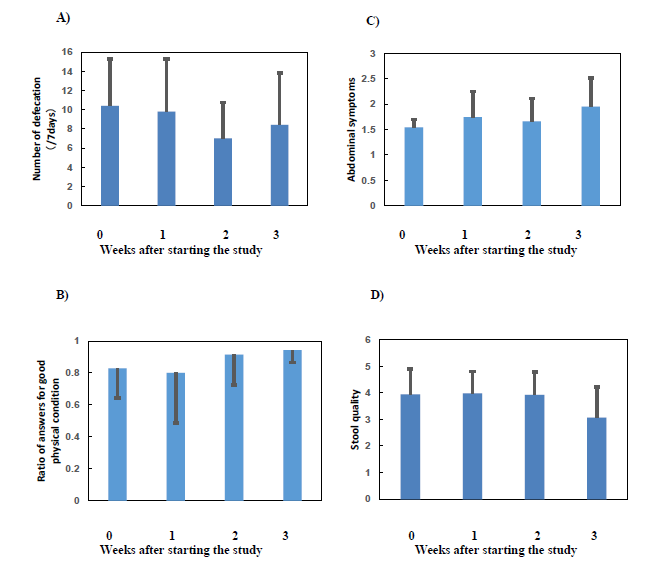
Figure 1.Results of daily questionnaires on health status during the study periods. Subjects completed a questionnaire once daily for 28 days during the study period. The results are shown as A) the mean number of bowel movement during each period (1st, 2nd, 3rd and 4th week of the study period), B) physical condition (1: good, 2: not good) for the same periods of time as A), C) abdominal symptoms (bloating and rumbling) (1: few, 2: sometimes, 3: often) for the same periods of time as A), D) stool properties according to the Bristol Stool Form Scale for the same periods of time as A). Results are shown as the means and the standard deviations of the 5 subjects.
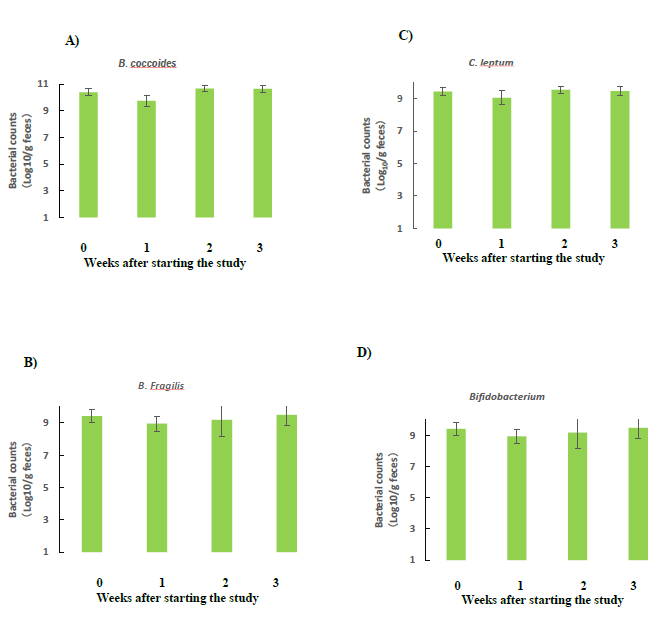
Figure 2.Changes in the population levels of the 4 predominant anaerobic bacterial groups during the study periods. DNA fractions were extracted from the fresh feces were obtained from 5 subjects once at the study periods (1st, 2nd, 3rd and 4th week after the start), and the bacterial counts of 4 predominant anaerobic bacterial groups, A): Clostridium coccoides group, B) Clostridium leptum subgroup, C) Bacteroides fragilis group, D) genus Bifidobacterium in the fecal DNAs were analyzed by quantitative PCR method. Results are shown as the means and the standard deviations of the 5 subjects.
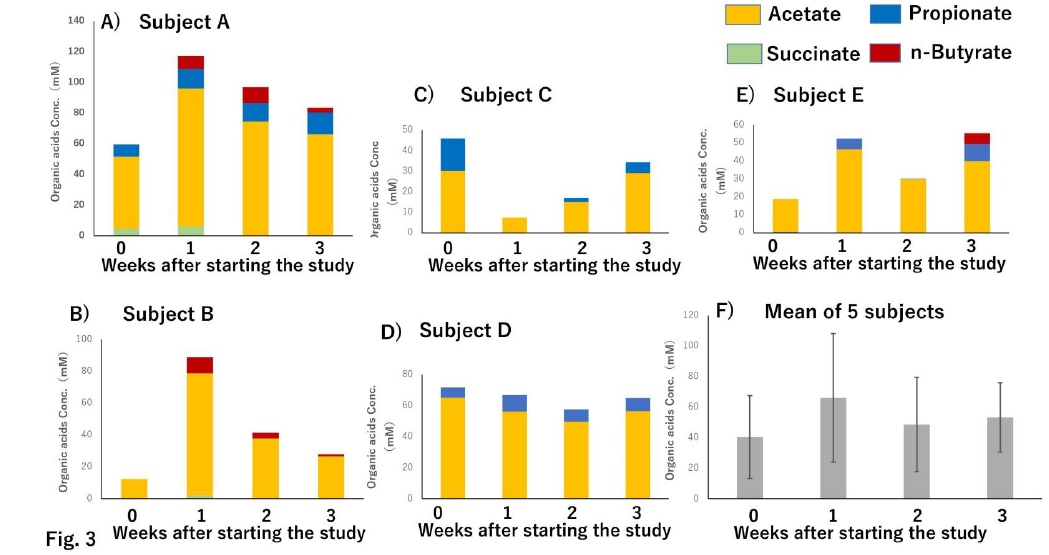
Figure 3.Changes in the concentrations of the fecal organic acids during the study periods. Organic acids were extracted from the fresh feces obtained from 5 subjects once at each study periods (1st, 2nd, 3rd and 4th week after the start), and the concentrations of organic acids were analyzed by HPLC. Results are shown as the means and the standard deviations of the 5 subjects. A): subject A, B) subject B, C) subject C, D) subjects D, E) subject E, F) mean of the 5 subjects and the standard deviation.
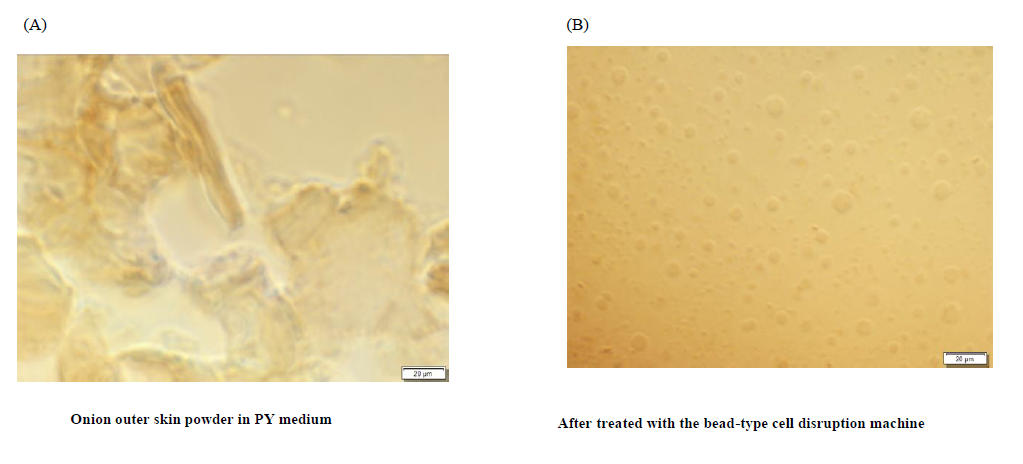
Figure 4.Micro fibrillation of onion outer skin powder by mechanical disruption. Onion outer skin powder was suspended at 10 mg in 1 ml of sterile anaerobic medium, and mixed with 4 g of Zirconia beads with a diameter of 0.5 mm in an micro tube, and then disrupted in a bead-type cell disruption machine (Multi-beads shocker, 2700rpm×60s on time/60s off time for 5 cycles at 0℃). A) before beating, B) after beating. (x 20)
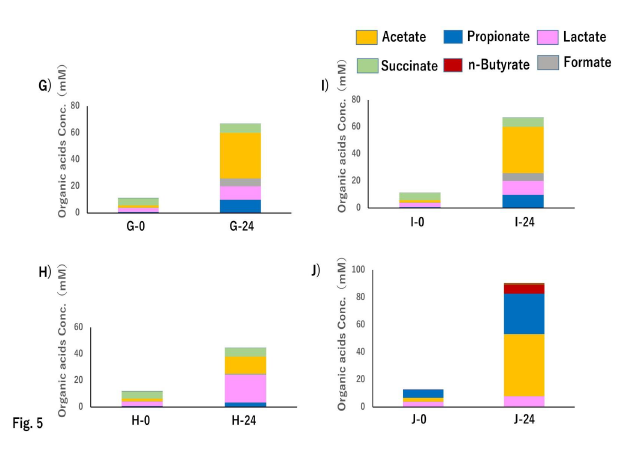
Figure 5.Increased concentration of organic acids during fecal culture with existence of onion outer skin powder. Fecal suspensions (volunteers G, H, I, or J) in PY medium at a concentration of 100mg feces/ml were incubated with existence of onion outer skin powder at a concentration of 20 mg/ml anaerobically at 37℃ for 24h. The culture supernatant was obtained at time 0 and 24hr, and the organic acid concentrations in the supernatants were analyzed by HPLC.
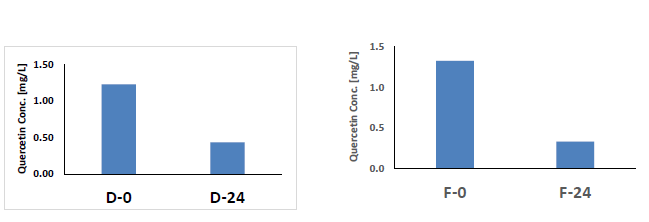
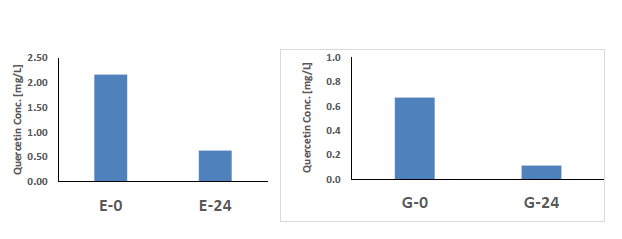
Figure 6.Decreased concentration of quercetin during fecal culture with existence of onion outer skin powder. Fecal suspensions (volunteers G, H, I, or J) in PY medium at a concentration of 100mg feces/ml were incubated with existence of onion outer skin powder at a concentration of 20 mg/ml anaerobically at 37 ℃ for 24h. The culture supernatant was obtained at time 0 and 24hr, and the organic acid concentrations in the supernatants were analyzed by HPLC.
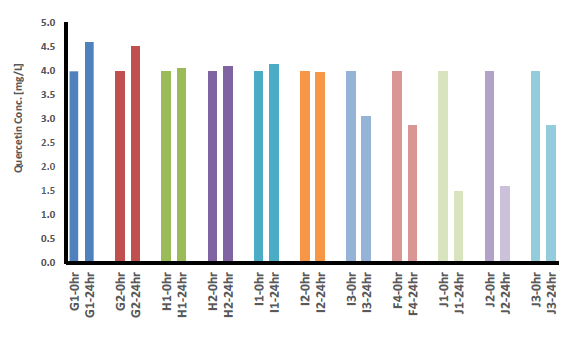
Figure 7. Differences in the quercetin degrading activity of fecal isolates during co-culture with onion outer skin powder. Eleven bacterial strains (designated G1 ~ J3) isolated from the 4 volunteers were co-cultured with onion powder skin at a concentration of 20 mg/ml anaerobically at 37℃ for 24hr, and the concentration of quercetin in the culture supernatant both at the start and 24hr after the incubation was determined by HPLC.
In vitro Human Fecal Culture Study
Next, in order to figure out the metabolic activity of intestinal microorganisms, fecal culture system was prepared as follows. Briefly, approximately 0.5 g of fresh feces obtained from 4 healthy adult volunteers (designated H, I, J, and K: All of them were independent from the intervention study) were suspended in PY broth at a concentration of 100 mg feces/ml. The stool suspension was once centrifuged at 10,000 x g for 5 minutes, and the supernatant was removed. The precipitate was resuspended in the anaerobic PY broth containing test compound: The test compound was suspended at about 100 mg in 10 ml of sterile anaerobic medium and disrupt in a bead-type cell disruption machine (Multibead shocker, MB1001C(S), YASUI KIKAI corp, Osaka, Japan) at 0℃. The crushed suspension was centrifuged at 10,000 x g for 5 minutes, and the centrifuged supernatant was diluted with fresh medium for human fecal culture at a final concentration of 1% (v/v). As shown in Figure 4, weakly magnified (x20) optical microscopy images of the suspension of onion skin grains after mechanical crushing treatment showed that the particles were in diameter ranging from a few to 10 microns. There were no colony formation of the treated suspension on GAM agar plates after anaerobic culture for 3-4 days at 37℃、showing the sterile condition of the sample.
As the results, in PY medium with 1% dextrose, which was used as a negative control, quercetin was not detected (data not shown), and there was no increase in quercetin concentration after incubation of the medium itself at an anaerobic atmosphere of 4.5% CO2, 3.6% H2 in N2 at a temperature of 37℃ and a humidity of 40% for 24 hr (data not shown). Quercetin concentration decreased in all subjects' stool culture (Figures 5H - K) after 24 hours of incubation with existence of crushed onion outer skin powder.
As for 4 subjects' stool cultures, the mean quercetin metabolism rate after 24 hours of the fecal culture with crushed onion skin grains was 73.5% (±7%), H: 64.8%, I: 70.9%, J: 75.0%, K: 83.4%). Concentrations of organic acids in each fecal suspensions increased after an anaerobic culture for 24 hr (Figures 6H-K): the total organic acids concentration of 11-13 mg/L at the starting period to 45 (J) to 90 (K) mg/L at the end of cultivation.
The compositions of the molecular species were unique for each culture, and acetate, propionate and lactate were the major species of highest concentrations in all the cultures. These results suggest that the onion outer skin powder rich in fiber works as the good nutritional source for the intestinal bacteria which use the carbohydrates and produce significant amounts of organic acids in a manner specific to host indigenous microbiota.
Next, we investigated the ability of the bacterial strains isolated from each fecal culture to degrade quercetin in vitro. Each of the 11 isolates was suspended in PY medium containing onion peel powder and incubated anaerobically at 37℃ for 24 hours. Quercetin concentrations in the culture supernatants were determined by HPLC. Briefly, the culture supernatant was were heated at 90℃ for 60min, and suspended in methanol and filtrated, which was then applied to HPLC (Column: L-column ODS, Detector: FP-4025 fluorescence detector; Jasco Corporation, Tokyo, Japan). As shown in Figure 7, 5 strains (I-1, I-2, J-1, J-2, J-3) out of 11 strains tested had significant activity to break down quercetin, while others did not show significant degrading activity (Figure 6). And all the strains with the highest activities to degrade quercetin were derived from the subjects I and J whose feces showed high quercetin degrading activity (Figures 5, 6).
Discussion and Conclusion
From the perspective of the SDGs, this study can be said to fit into goal 3 (good health and well-being) and goal 12 (Responsible consumption and production). According to the annual report on the environment in Japan 2019 by the Japanese Ministry of Environment, it has been reported that so-called "food loss," was 6.43 million tons in fiscal 2016, and in terms of awareness of the 3Rs (Reduce, Reuse, Recycle), public’s consideration for waste reduction, and green purchasing has been decreasing. The co-investigator company's corporate concept is to reuse ingredients that are usually discarded as industrial waste, such as onion outer skin and burdock skin which have a higher content of active ingredients such as dietary fiber and quercetin rather than in the edible part. Then, our goal reflecting the SDGs is to clarify the role of gut microbiota in producing active compounds from such food components to make the host healthier.
The idea of “WASHOKU; traditional dietary cultures of the Japanese” has been added to the on the Representative List of the Intangible Cultural Heritage of UNESCO [12]. Actually, the word "Wa" in Japanese means "Japanese" and "shoku" means "to eat. The idea is based on Japanese traditional way of respecting for nature, and has characteristics such as a wide variety of fresh food ingredients according to the Japanese distinct four seasons and consideration of nutritional balance maintaining Japanese longevity. Although the strict definition of “Washoku” with regard to the component level has not been made so far, the combination of "rice, soup, vegetables (accompaniments for rice dish) and pickles" has been considered to be the basic form of Japanese food. And fermented foods with various forms and dietary fibers in various vegetables including roof crops and seaweeds seem the unique elements of “Washoku”, suggesting that the concept of Washoku can be characterized by the vegetarian concept with lower amounts of protein and fat derived from animal meat. Moreover, the Washoku food ingredients include plant polyphenols such as soy isoflavons in the soy foods such as Miso (a fermented food made by adding salt and koji mold to grains such as soybeans, rice, and wheat), soy source, Tofu and Natto (fermented soybeans).
From a microbiological point of view, fermenting microorganisms such as lactic acid bacteria, yeast, and koji mold (Aspergillus oryzae) play an extremely important role in fermented foods. Probiotics has been defined as “Live microorganisms that, when administered in adequate amounts, confer a health benefit on the host” [13] whereas prebiotics are recognized as “a substrate that is selectively utilized by host microorganisms conferring a health benefit” [14]. More recently, fermented foods have been defined as “”foods foods made through desired microbial growth and enzymatic conversions of food components” [15].
According to these definitions, fermented foods themselves are not probiotics, but the viable fermenting microorganisms in the foods may have potential probiotic activity. Also, a variety of plant dietary fibers have potential to function as prebiotics. In this study, the data suggest a potential prebiotic functionality of onion outer skin powder as shown by the increase in fecal SCFA concentration after intake of onion outer skin powder, although the effect was not shown in all the subjects. Of course, as shown in the fecal culture data, the metabolic function such as to produce SCFAs and break down quercetin was quite different according to the host microbiota community.
With regard to quercetin metabolism, various kinds of intestinal anaerobic bacteria such as Eubacterium ramulus and Clostridium orbiscindens and specific strains have been reported to degrade quercetin [16]. More recently, Tamura et al. have conducted a fecal culture with existence of quercetin and reported that the abundance of Sutterellaceae and Oscillospiraceae in the fecal microbiota was negatively correlated whereas that of Fusobacteriaceae and Enterobacteriaceae was positively correlated with quercetin concentration and suggested that Fusobacteriaceae and Enterobacteriaceae affect quercetin bioavailability by directly or indirectly inhibiting the degradation of quercetin by other bacteria [17]. Quercetin is metabolized by intestinal bacteria and converted into various substances such as 3,4-dihydroxyphenylacetic acid, 3-(3-hydroxyphenyl) propionic acid, 3,4-dihydroxybenzoic acid and 4-hydroxybenzoic acid which have been reported to have their own bioactivity [7]. With respect to our isolated strains, studies are in progress to identify the bacterial species which have quercetin degradation activity, and the same research direction would apply to the identification of enteric bacteria that break down onion skin grains to produce organic acids.
In conclusion, it is hoped that this kind of research will lead to more effective ways of bioavailability of the plant outer skin containing high amounts of active ingredients such as quercetin and dietary fiber that are difficult to digest by possible synergistic combination with the indigenous probiotic inhabitants that are able to assimilate these compounds.
Disclosure Statement
This work was supported by IST Corporation, Japan. The funding agency had no role in study design, data collection and analysis, decision to publish, or preparation of the manuscript.
Acknowledgements
The authors would like to thank Drs. Koji Kasahara and Hiroshi Hosoda for active discussions and Dr. Takashi Kurakawa and Mr. Toshihiko Takada for their technical advices during this study.
References
1. Kawai Y, Nishikawa T, Shiba Y, et al. Macrophage as a target of quercetin glucuronides in human atherosclerotic arteries: implication in the anti-atherosclerotic mechanism of dietary flavonoids. J Biol Chem. 2008 ;283(14):9424-34.
2. Li Y, Yao J, Han C, et al. Quercetin, Inflammation and Immunity. Nutrients, 2016;8(3):167.
3. Dabeek WM, Marra MV. Dietary Quercetin and Kaempferol: Bioavailability and Potential Cardiovascular-Related Bioactivity in Humans. Nutrients. 2019;11(10):2288.
4. Tang SM, Deng XT, Zhou J, et al. Pharmacological basis and new insights of quercetin action in respect to its anti-cancer effects. Biomed Pharmacother. 2020;121:109604.
5. Marunaka Y, Marunaka R, Sun H, et al. Actions of quercetin, a polyphenol, on blood pressure. Molecules. 2017;22(2):209.
6. Lewis SJ, Heaton KW. Stool form scale as a useful guide to intestinal transit time. Scand J Gastroenterol. 1997;32(9):920-4.
7. Santangelo R, Silvestrini A, Mancuso C. Ginsenosides, catechins, quercetin and gut microbiota: Current evidence of challenging interactions. Food Chem Toxicol. 2019;123:42-49.
8. Sonnenburg ED, Smits SA, Tikhonov M, et al. Diet-induced extinction in the gut microbiota compounds over generations. Nature. 529: 212-215, 2016.
9. Li X, Shimizu Y, Kimura I. Gut microbial metabolite short-chain fatty acids and obesity. Biosci Microbiota Food Health. 2017;36(4):135-140.
10. Lewis SJ, Heaton KW. Stool form scale as a useful guide to intestinal transit time. Scand J Gastroenterol. 1997;32(9):920-924.
11. Matsuki T, Watanabe K, Fujimoto J, et al. Use of 16S rRNA gene-targeted group-specific primers for real-time PCR analysis of predominant bacteria in human feces. Appl Environ Microbiol. 2004;70(12):7220-728.
12. "Washoku". UNESCO Culture Sector. Retrieved 2013-12-08..
13. Hill C, Guarner F, Reid G, et al. Expert consensus document. The International Scientific Association for Probiotics and Prebiotics consensus statement on the scope and appropriate use of the term probiotic. Nature Rev Gastroenterol Hepatol. 2014; 11: 506-514.
14. Gibson GR, Hutkins R, Sanders ME, et al. Expert consensus document: The International Scientific Association for Probiotics and Prebiotics (ISAPP) consensus statement on the definition and scope of prebiotics. Nat Rev Gastroenterol Hepatol. 2017;14(8):491-502.
15. Marco ML, Sanders ME, Gänzle M, et al. The International Scientific Association for Probiotics and Prebiotics (ISAPP) consensus statement on fermented foods. Nat Rev Gastroenterol Hepatol. 2021.
16. Schneider H, Schwiertz A, Collins MD, et al. Anaerobic transformation of quercetin-3-glucoside by bacteria from the human intestinal tract. Arch Microbiol. 1999;171(2):81-91.
17. Tamura M, Hoshi C, Kobori M, et al. Quercetin metabolism by fecal microbiota from healthy elderly human subjects. PLoS One. 2017;12(11):e0188271.
Received: July 28, 2020;
Accepted: August 18, 2020;
Published: August 20, 2020.
To cite this article : Nomoto K, Yamaguchi G, Suzuki E, et al. Effect of Continuous Intake of Onion Outer Skin Powder on Human Microbiota: A Preliminary Intervention Study and In Vitro Fecal Culture Study. British Journal of Gastroenterology. 2020; 2:4.
© Nomoto K, et al. 2020.
